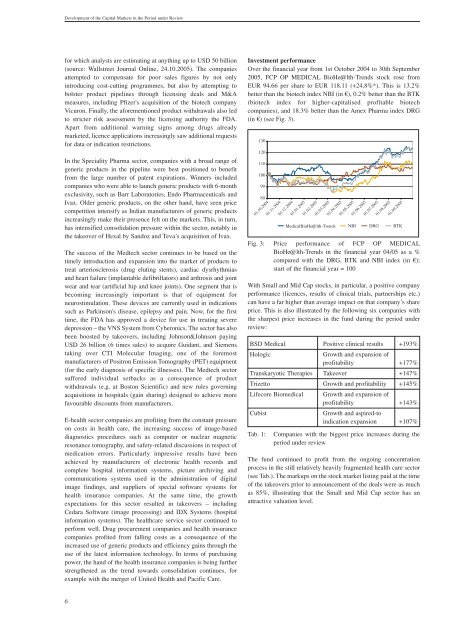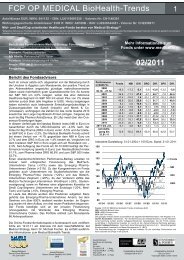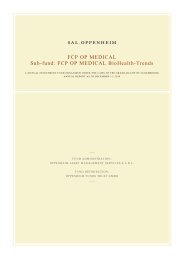FCP OP MEDICAL BioHe@lth-Trends - medical.lu
FCP OP MEDICAL BioHe@lth-Trends - medical.lu
FCP OP MEDICAL BioHe@lth-Trends - medical.lu
You also want an ePaper? Increase the reach of your titles
YUMPU automatically turns print PDFs into web optimized ePapers that Google loves.
Development of the Capital Markets in the Period under Review<br />
for which analysts are estimating at anything up to USD 50 billion<br />
(source: Wallstreet Journal Online, 24.10.2005). The companies<br />
attempted to compensate for poor sales figures by not only<br />
introducing cost-cutting programmes, but also by attempting to<br />
bolster product pipelines through licensing deals and M&A<br />
measures, inc<strong>lu</strong>ding Pfizer's acquisition of the biotech company<br />
Vicuron. Finally, the aforementioned product withdrawals also led<br />
to stricter risk assessment by the licensing authority the FDA.<br />
Apart from additional warning signs among drugs already<br />
marketed, licence applications increasingly saw additional requests<br />
for data or indication restrictions.<br />
In the Speciality Pharma sector, companies with a broad range of<br />
generic products in the pipeline were best positioned to benefit<br />
from the large number of patent expirations. Winners inc<strong>lu</strong>ded<br />
companies who were able to launch generic products with 6-month<br />
exc<strong>lu</strong>sivity, such as Barr Laboratories, Endo Pharmaceuticals and<br />
Ivax. Older generic products, on the other hand, have seen price<br />
competition intensify as Indian manufacturers of generic products<br />
increasingly make their presence felt on the markets. This, in turn,<br />
has intensified consolidation pressure within the sector, notably in<br />
the takeover of Hexal by Sandoz and Teva’s acquisition of Ivax.<br />
The success of the Medtech sector continues to be based on the<br />
timely introduction and expansion into the market of products to<br />
treat arteriosclerosis (drug e<strong>lu</strong>ting stents), cardiac dysrhythmias<br />
and heart fai<strong>lu</strong>re (implantable defibrillators) and arthrosis and joint<br />
wear and tear (artificial hip and knee joints). One segment that is<br />
becoming increasingly important is that of equipment for<br />
neurostimulation. These devices are currently used in indications<br />
such as Parkinson's disease, epilepsy and pain. Now, for the first<br />
time, the FDA has approved a device for use in treating severe<br />
depression – the VNS System from Cyberonics. The sector has also<br />
been boosted by takeovers, inc<strong>lu</strong>ding Johnson&Johnson paying<br />
USD 26 billion (6 times sales) to acquire Guidant, and Siemens<br />
taking over CTI Molecular Imaging, one of the foremost<br />
manufacturers of Positron Emission Tomography (PET) equipment<br />
(for the early diagnosis of specific illnesses). The Medtech sector<br />
suffered individual setbacks as a consequence of product<br />
withdrawals (e.g. at Boston Scientific) and new rules governing<br />
acquisitions in hospitals (gain sharing) designed to achieve more<br />
favourable discounts from manufacturers.<br />
E-health sector companies are profiting from the constant pressure<br />
on costs in health care, the increasing success of image-based<br />
diagnostics procedures such as computer or nuclear magnetic<br />
resonance tomography, and safety-related discussions in respect of<br />
medication errors. Particularly impressive results have been<br />
achieved by manufacturers of electronic health records and<br />
complete hospital information systems, picture archiving and<br />
communications systems used in the administration of digital<br />
image findings, and suppliers of special software systems for<br />
health insurance companies. At the same time, the growth<br />
expectations for this sector resulted in takeovers – inc<strong>lu</strong>ding<br />
Cedara Software (image processing) and IDX Systems (hospital<br />
information systems). The healthcare service sector continued to<br />
perform well. Drug procurement companies and health insurance<br />
companies profited from falling costs as a consequence of the<br />
increased use of generic products and efficiency gains through the<br />
use of the latest information technology. In terms of purchasing<br />
power, the hand of the health insurance companies is being further<br />
strengthened as the trend towards consolidation continues, for<br />
example with the merger of United Health and Pacific Care.<br />
6<br />
Investment performance<br />
Over the financial year from 1st October 2004 to 30th September<br />
2005, <strong>FCP</strong> <strong>OP</strong> <strong>MEDICAL</strong> <strong>BioHe@lth</strong>-<strong>Trends</strong> stock rose from<br />
EUR 94.66 per share to EUR 118.11 (+24.8%*). This is 13.2%<br />
better than the biotech index NBI (in €), 0.2% better than the BTK<br />
(biotech index for higher-capitalised profitable biotech<br />
companies), and 18.3% better than the Amex Pharma index DRG<br />
(in €) (see Fig. 3).<br />
130<br />
120<br />
110<br />
100<br />
90<br />
80<br />
01.10.2004<br />
01.11.2004<br />
01.12.2004<br />
01.01.2005<br />
01.02.2005<br />
01.03.2005<br />
01.04.2005<br />
01.05.2005<br />
01.06.2005<br />
01.07.2005<br />
01.08.2005<br />
01.09.2005<br />
Medical<strong>BioHe@lth</strong>-<strong>Trends</strong> NBI DRG BTK<br />
Fig. 3: Price performance of <strong>FCP</strong> <strong>OP</strong> <strong>MEDICAL</strong><br />
<strong>BioHe@lth</strong>-<strong>Trends</strong> in the financial year 04/05 as a %<br />
compared with the DRG, BTK and NBI index (in €);<br />
start of the financial year = 100<br />
With Small and Mid Cap stocks, in particular, a positive company<br />
performance (licences, results of clinical trials, partnerships etc.)<br />
can have a far higher than average impact on that company’s share<br />
price. This is also il<strong>lu</strong>strated by the following six companies with<br />
the sharpest price increases in the fund during the period under<br />
review:<br />
BSD Medical Positive clinical results +193%<br />
Hologic Growth and expansion of<br />
profitability +177%<br />
Transkaryotic Therapies Takeover +147%<br />
Trizetto Growth and profitability +145%<br />
Lifecore Bio<strong>medical</strong> Growth and expansion of<br />
profitability +143%<br />
Cubist Growth and aspired-to<br />
indication expansion +107%<br />
Tab. 1: Companies with the biggest price increases during the<br />
period under review<br />
The fund continued to profit from the ongoing concentration<br />
process in the still relatively heavily fragmented health care sector<br />
(see Tab.). The markups on the stock market listing paid at the time<br />
of the takeovers prior to announcement of the deals were as much<br />
as 85%, il<strong>lu</strong>strating that the Small and Mid Cap sector has an<br />
attractive va<strong>lu</strong>ation level.





